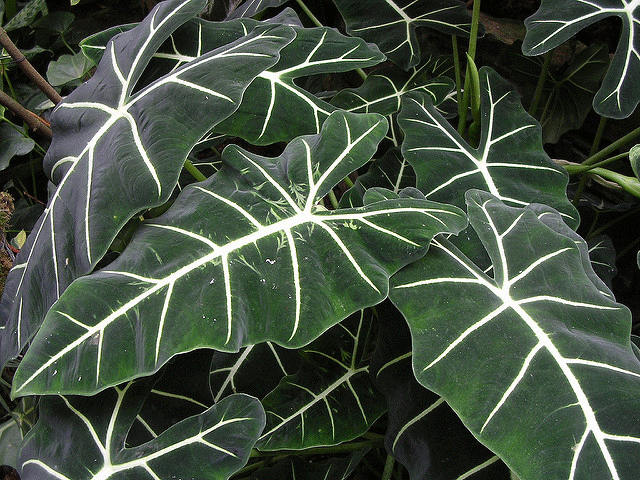African mask is beloved for dark green, deep V-shaped leaves with ribs and edges marked in bright creamy white. Jaunty and full of attitude, it laughs off legendary arguments about its parentage and lack of official standing by many in the scientific community. This colorful plant is neither a species nor found in any rainforest, including those in Southeast Asia where its relatives are native. Experts have traced its family tree back to Amazon Nursery, which was owned by Miami postman Salvatore Mauro in the 1950s. Whether it is a hybrid or a stable offspring of another Alocasia matters less than its ability to deliver distinctive tropical flair. Outdoors, African mask haunts the shade while indoors, any bright room will do for this long-lived plant. Aroids, as plants in this family are called, display rowdy, outrageous leaves, especially this rogue member.
Plant Family
Araceae
Other Common Name
Alligator plant
Bloom Period and Seasonal Color
Yellow flowers appear sporadically amid boldly patterned leaves on older plants
Mature Height × Spread
Up to 3 ft. × 2 ft.
When, Where, and How to Plant
Outdoors, select a site that offers light but is shaded from direct sun all day. A tabletop near a bright window amid a group of other plants will provide ample light and humidity inside a home or office. Prepare the garden soil or a container growing mix that is richly organic yet well drained. Use ground bark, compost, or compost/ manure to enrich soils. Grow African masks away from wind and salt spray to avoid shredded and pocked leaves. Plant clumps 1 to 2 feet apart in beds. Repot when roots are visible in the drain hole, when water rushes through without percolating into the soil, or if the pot tips easily.
Growing Tips
African mask plants that are allowed to dry out will go dormant. Reservoir pots can be filled on your schedule, and drip irrigation or garden bed soakers can be automated to ensure good hydration. Fertilize moderately using a granular formula three or four times annually, or use a soluble fertilizer mixed at half strength every other month. Keep organic mulch around plants in beds and pots. Its leaf tips may brown if the humidity is too low or if your tap water is unsuitable.
Care and Propagation
Keep an eye out for spider mites, mealybugs, and scale insects. To propagate, divide rhizomes while they’re dormant or separate offsets from the mother plant. See “Propagation” (page 36) for details.
Companion Planting and Design
African masks can hold center stage alone or surrounded by a bed of nerve plants. Pair it with striped blushing bromeliads, golden brush gingers, or ruffle ferns for a bold tropical vignette.
Try These
Dwarf varieties and selections have confusing names too. For example, Alocasia ‘Poly’ is also known as ‘Polly’.


